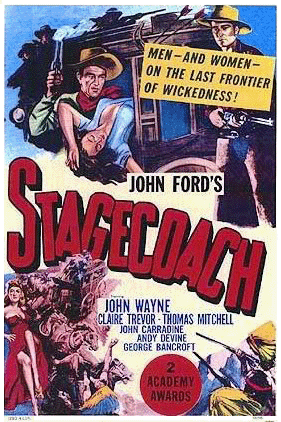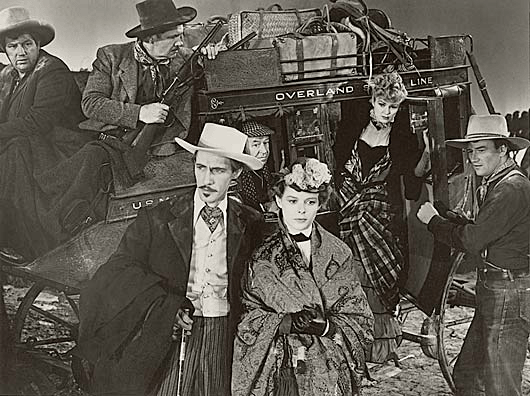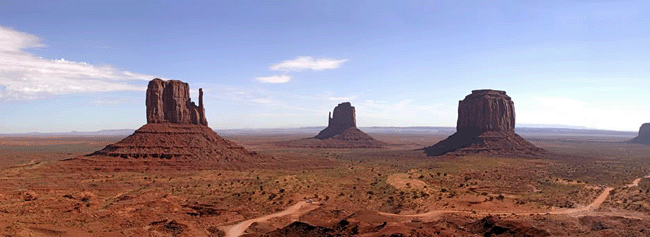John Ford's >
movie Stagecoach
(1939) has a fair claim to be the most
influential Western ever made. It was the director's first attempt into the
genre since 1926 and his first to be shot against the impressive scenery of
Monument Valley. Ford was the film-making counterpart to Zane Grey, the
ex-dentist turned writer who single-handedly received the cowboy novel. Just
as Grey's combination of piety and lyricism inspired a sense of awe in his
readers, the movie Stagecoach ensured that Westerns on the big screen
would once again be taken seriously.
During the 1930s, they had fallen from grace.
Rather than making energetic tales about pioneers heading westward hol,
Hollywood produced a complacent series of unstimulated B-pictures, many
starrring > John Wayne,
whose standing with the studios was much reduced since his first significant
role in Raoul Walsh's epic, The Big Trail, in 1930. This was the era of
Hopalong Cassidy, the Three Mesquiteers, and the singing cowboy Gene Autry, to
be followed a generation later by Roy Rogers.
|

|
The movie Stagecoach was loosely based
on Ernest Haycox's The Stage to Lordsburg, a short story published in Collier's
Magazine in 1937, but Ford later claimed that the real inspiration was the
Guy de Maupassant story, > Boule de Suif, a
cutting story about a coach journey across Prussian-occupied France. Dudley
Nichols (a Ford regular) adapted the novella, and with this test script Ford
tried to convince various studio's in making it into a movie. But no one was
interested, they said, that it was a Western and that nobody makes Westerns
anymore.
Ford's friend, Joseph P. Kennedy, father of
later president John F. Kennedy, was interested at first but the boss of >
RKO
Radio Pictures decided to withdraw at the last moment. He also claimed that there
was no interest in Westerns anymore with the public. Besides this, his
advisors thought that the storyline was too weak for a feature-length movie.
Producer Walter Wanger, who was committed to United Artists for making
one last movie, finally accepted the movie Stagecoach because he
thought he could make it into a cheap 'star movie' with Gary Cooper as Ringo
Kid and Marlene Dietrich as Dallas. John Ford convinced Wanger to refrain from
Cooper and Dietrich, by saying that they were too expensive. He said that you
have to produce such a Western for peanuts, a "quickie" with a
minimal amount of money.
|
From that moment Wanger didn't interfere with
the project anymore, giving Ford all the freedom. Ford arranged the casting,
and quickly went to work.
The attack and the pursuit of the Indians were shot
in two days in Monument Valley. The movie Stagecoach was filmed fast
and efficient, almost like a B-picture. Ford edited the film as it were 'in
the camera's' and the camera's were attached to the cars that drove next to
the coach and the horses, and sometimes even between the hordes of Indians.
Film journalists later asked Ford why the Indians not simply killed the horses
in front of the coach to shorten the pursuit. Ford replied that the Indians
were not interested in the "pale-faces" but in the horses.
|

|
| From left
to right: Andy Devine, George Bancroft, John Carradine, Donald Meek,
Louise Platt, Claire Trevor, John Wayne. |
In the story, the travellers are held up at an
Inn. The most benevolent and kind-hearted among them is a prostitute,
nicknamed Boule de Suif. The other travellers force her to sleep with their
captor so that they can resume their journey. Once she does so, they
immediately ignore her -- although she was only doing what they'd demanded.
But if one examines Ford's movie Stagecoach closely you'll see it's not
that austere. Above all, it's a tale of salvation -- on screen and off. In the
progress of their hazardous journey across Indian country, the passengers
overcome their own shady pasts. The alcoholic surgeon Dr Boone (Thomas
Mitchell, oscar winner Best Supporting Actor) conquers the DTs and the threat
of persevering and hostile (ruthlessly burlesqued) Indians to deliver a baby;
Dallas > (Claire Trevor), the Boule de Suif character with the heart of
gold wins over the good folk who ignored her at first through patience and
kindness; the harsh outlaw, the Ringo Kid (John Wayne), whom Dallas has a
crush on, displays heroic deeds during the Indian attack and then avenges the
death of his father at the hands of the Plummer gang.
The movie Stagecoach combined
spectacular mise en scène, magnificent stunts (including the amazing sequence
in which Yakima Canutt, playing an Apache, falls in front of the coach and is
run over by it), and powerful characterisation. The dialogue by Dudley
Nichols, was far complexer than the sententious one-liners found in the B
-Westerns of that period. Real stagecoachers used to pass through Monument
Valley. Their tracks were still visible. Ford shows them in the film, as if to
emphasize its genuineness.
|

|
|
John
Ford's favorite location Monument Valley |
After the movie Stagecoach, which was a
huge box office success, nobody could ever again sneer at the Western -- 'one
of the few art forms the Americans can lay claim to'. as Clint Eastwood put
it. As commented before in the article on >
John Ford
the influence is still recognizable in the Westerns made today, like if
one watches Kevin Coster's Wyattt Earp (1994) or Clint Eastwood's Unforgiven
(1992) one can see the inspiration of the movie Stagecoach in the
story development or camerawork. Ford bought the rights of Ernest Haycox's The
Stage to Lordsburg for $2500,-, an amount that's not that tremendous for
what is now known as a milestone in the history of movie art.